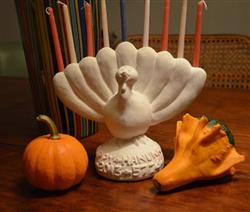Thanksgivukah
By TMoM Team Member Dani Luft
What do you get when you combine the American holiday of Thanksgiving with the Jewish holiday of Hannukah? Well, “Thanksgivukah,” of course! That is what is happening this year! November 28, 2013 to be exact. The day that Americans are grateful and thankful, where we eat Turkey and relax with family and friends is also the second night of the Jewish holiday of Hannukah, where we eat latkes and spin dreidles. If you need a refresher of why Jewish people celebrate Hannukah, last year I blogged about the Jewish holiday here.
So, why is this once-in-a-lifetime event happening like this? The Jewish calendar is lunar and does not correspond with the Gregorian calendar. The last time this happened, where the two holidays overlapped was 1888. It won’t happen again for another 70,000 years!!
After coming up with the new name of “Thanksgivukah” for this year’s phenomenon, some people are going nuts over this—making t-shirts, toys, serving dishes, anything to commercialize the holiday. New and exciting recipes and menus are emerging combining the two holidays. For example, one popular American dessert on Thanksgiving is pecan pie. Delicious ooey, gooey, nutty filling all forced in a delicious buttery pie shell! One popular Jewish dessert is called rugelach (Ruh-ge-lach), which is similar to a pastry, usually with a jelly filling. A Thanksgivukah recipe might be a pecan rugelach to unite the two. Another example of a recipe marriage would be a possible cranberry noodle kugel. Cranberries: a symbol of fall and winter. Kugel: Jewish noodle pie.
On Hannukah, we light one candle on the Menorah for each of the eight nights celebrated. This year, turkey menorahs have been bought to symbolize the celebration of both Thanksgiving and Hannukah. See the Menurkey here. See what they did? MENorah + turKEY= Menurkey.
While I appreciate the excitement of this once-in-a-lifetime experience, it is also bittersweet. Like many other Jews and gentiles, the post-Thanksgiving period is a time to anticipate the upcoming festive winter holidays. Although some may dislike the commercialization of the season, it’s something I like to participate in. Since Hannukah typically falls around Christmas, and sometimes even during Christmas, my family can participate in the winter holiday celebrations. While we don’t have Santa Claus, we have 8 nights of presents and candlelighting. We don’t sing “Hark the Harold, Angels Sing” because we sing “Oh Hannukah Oh Hannukah, come light the Menorah!” Both holidays are wonderful and beautiful.
So this year, when the rest of the world is preparing for Christmas, decorating their trees, preparing menus, picking out holiday attire, and rushing to buy the last few gifts, my family will be putting away our menurkeys, packing up our dreidles, and finishing the leftover latkes looking forward to next year when we can spread out our holiday cheer just a little and share “our” holiday season with the rest of the world.
Fortunately, we live in an inclusive society, and we have friends who like to share their holiday traditions. Growing up, I would go to friends’ houses and help them hang ornaments on their tree, attend Christmas parties, and give Christmas gifts to my friends. I love how truly quiet and calm it is outside. We take our children for a drive each year to look at the lights and explain that while we don’t celebrate Christmas, it is a beautiful holiday and we should appreciate that so many families get to be with each other and enjoy the day together. I wrote in last year’s blog how so many from the Jewish community volunteer in local hospitals so the hospital workers can enjoy the day off with their family. When my kids get older and are allowed to help out, we will do that, too.
This year, I will just have to take comfort in knowing that we had one heck of a combined holiday that will forever be etched in our memory as Thanksgivukkah 2013 and look forward to next year when we can have two separate holidays again.

